SHINTO AND JAPANESE CULTURE
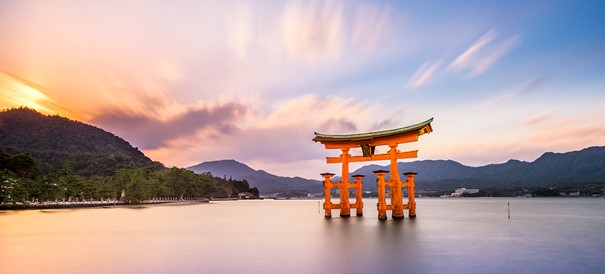
What is Shinto ?
Shinto
is considered as Japan’s indigenous religion and as a nature religion. It revolves around the numerous kami (“gods” or “spirits”), supernatural entities believed to inhabit all things. The chinese equivalent of “kami” is “SHIN” , and “TO” means “way” in Sino-Japanese. The word shinto means literally “the way of the gods”.
There is no central authority in control of the movement and much diversity exists among practitioners. There is no hierarchy among kami who are worshiped at kamidana private or public shrines. The latter are staffed by priests, known as kannushi, who oversee offerings of food and drink to the specific kami enshrined at that location. This is done to cultivate harmony between humans and kami and to solicit the latter’s blessing. Other common rituals include the kagura ritual dances, rites of passage, and seasonal festivals.
Shinto does not emphasize specific moral codes although it places a major conceptual focus on ensuring purity, largely by cleaning practices such as ritual washing and bathing. Shinto has no single creator or specific doctrinal text. Kannagara (“way of the kami”) describes the law of the natural order and certain ethical views, focused on sincerity (makoto) and honesty (tadashii). Makoto is regarded as a cardinal virtue in Japanese religion more broadly.
Belief in kami can be traced to Japanese antiquity (5th century BC). After 300AC Buddhism entered Japan and in part influenced kami veneration. Religious syncretisation made kami worship and Buddhism functionally inseparable.
In Japan, there are around 80,000 public shrines some of which are classified as UNESCO World Heritage Sites.
Shinto and Japanese Traditional Dance

Japanese traditional dance
includes a number of Japanese dance styles with a long history and prescribed method of performance. Some of the oldest forms of traditional Japanese dance may be among those transmitted through the kagura tradition, or folk dances relating to food producing activities such as planting rice (dengaku) and fishing, including rain dances]
Kagura
describes the music and dance performed for the kami. Throughout Japanese history, this dance has played an important culture role and in Shinto it is regarded as having the capacity to pacify kami. There are two broad types of kagura:
– Imperial kagura, also known as mikagura performed at special places.
– Sato-kagura, descended from mikagura and performed at shrines.
Depending on the style, it is performed by miko (young women , serving the or by actors wearing masks to portray various mythological figures.
In ancient Japanese collections, dance is described as asobi, which in the old Japanese language means a ceremony that is designed to appease the spirits of the departed, and which was conducted at funeral ceremonies.
Matsuri
are public festivals and constitute a “ central act of Shinto worship” because Shinto is a “community- and family-based” religion. There are festivals for all seasons and related to harvest or plantations particularly rice Winter festivals, called fuyu no matsuri often feature on welcoming in the spring, expelling evil, and calling in good influences for the future
Processions or parades take place during Shinto festivals During public processions, the kami travel in portable shrines . And of course , dance has an important role
There are several types of traditional Japanese dance. The most basic classification is into two forms mai and odori
-The Mai style is reserved and typified by circling movements where the body is kept low to the ground. Noh Mai is a theatrical dance traced back to 13th Century whereas Jinta Mai is refined dance coming from pleasure quarters in Osaka and Tokyo
-The Odori style includes folk dances performed at annual Bon festival events and dances that were part of traditional kabuki performances. Odori style features larger movements and is typically more energetic
Examples of Japanse Dances
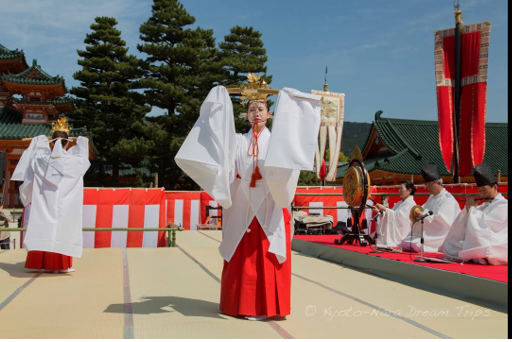
See the video
The Sacred Music of Mikagura: a brief look at an ancient ritual
The performance seen in the video is by the Tsurugaoka Hachimangu Shrine from Kamakura Japan It involves rare traditional musical instruments and a mesmerizing dance that has not changed much from the time of ancient Shinto rituals. The 24 musicians and dancers seen here in elegant traditional costumes are presided over by Head Priest Shigeho Yoshida, who believes in the importance of sharing indigenous Shinto concepts of reverence for the spirit in nature with people around the world.
Mikagura
It is a form of Japanese ceremonial music and dance which originated in rituals first conducted more than 1,000 years ago by Shinto shrine priests for the Imperial Court of Japan.
This style is still performed on the three Palace Sanctuaries every December, at the Imperial harvest festival and at major shrines.
Its music is gagaku , the elegant and refined music of the imperial court
The celebration of mikagura is divided into three parts:
• the reception of divinities coming down to earth;
• a longer part during which men offer gifts to the gods and distract them with humorous songs;
• a farewell to the divinities who ascend to heaven with songs composed of folk poems assembled and not created for this purpose.
Mikagura consists of two types of chants. The sacred songs and the dance songs played by different instruments.
The musicians and chorists are led by a ninchō (officiant)
Between each game, the ninchō explains the purpose of worship and dance.
Sato kagura
Also called village kagura, it is a popular form of kagura that presents ritualized dance-dramas reenacting mythological themes, including the primal restoration of sunlight to the world. It is often heard during festivals, when musicians accompany their songs on flutes and a variety of drums.
It is held in common sintoïst shrines generally danced by the mikos (young women serving the temple) accompanied by an instrumental ensemble hayashi composed by flutes , drum and cymbal From it originated two forms of theatre Nô and Kyōgen.
Two examples follow :
- miko kagura, performed by the mikos, and derived from ritual dances in which the miko appeared possessed by the kami and spoke, sang and danced as a god. This dance is often performed with ritual props, like small bells, twigs, and others
- izumo-ryū kagura that can be found in the dances of the Izumo region around the Izumo Shrine. The origin of the kagura dances as they are danced in Izumo is believed to be the gozakae ritual of the Sada shrine in Matsue near Izumo. (see next paragraph)

see the video :
Izumo Kagura Shimane,Yamata-no-Orochi, credit : karigrohncom
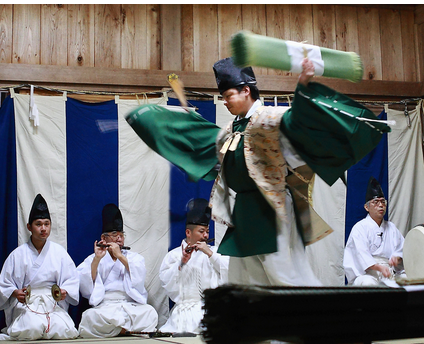
See the video
Sada Shin Noh, sacred dancing at Sada shrine credit : Unesco
Sada Shin Noh
Sada Shin Noh is a series of ritual purification dances, performed annually on September 24 and 25 at Sada Shrine, Matsue Town, Shimane Prefecture, Japan, as part of the gozakae ritual of changing mats into rush. The dances are performed to purify the new rush mats (goza) on which the guardian deities of the sanctuary will sit. The purpose of replacing mats is to attract their benefits to the community.
Various types of dance are performed on a purpose-built stage inside the shrine. For some dances, the dancers carry swords, sacred wooden sticks and bells; for others, they wear masks imitating the faces of elderly men or gods and bring Japanese myths to life. During the ritual gozamai dance, the dancers hold the rush mats to purify them before offering them to the gods. Musicians seated around the stage accompany the dances with their songs and instruments (flutes and drums).
Sada Shin Noh is passed down from generation to generation by members of the community – the priests cannot dance it.
The sacred dance of Sada shrine has been inscribed on the UNESCO list of intangible cultural heritage of humanity since 2011
MATSURI
Traditional Japanese folk festivals and celebrations that take place everywhere in Japan. Each district of a large city, each village or small town had its matsuri, that is to say its own festival both religious and secular in honor of a protective deity or a god important for the human group gathered
Some matsuri are religious mikoshi (sacred religious palanquin) processions, dedicated and devoted to deities, others consist of collective dances, the parade in the village of floats associated with each district, under the air of a matsuri-bayashi (its traditional music).
Matsuri are still today an opportunity for the Japanese to meet with friends to taste specialties in yatai (stands), watch fireworks, children to play games, and above all to (re) live local folklore.
The matsuri follow and mark the calendar.
In spring, for example, japanese celebrate the transplanting of rice and pray to protect themselves from epidemics.
In summer matsuri take place for protection against typhoons and ravages caused by insects. People also pray for their ancestors
In winter, they are related to the end of the year holidays
Three examples follow :
ON Matsuri
Since the 12th century, the ON-matsuri festival has been held at the Kasuga shrine. This was first organized during an epidemic to pray for the eradication of the plague and for the blessing of fruitful harvests. This historic festival is still one of the main festivals in Nara Prefecture today, attracting many people. The On-matsuri lasts 4 days, but the most beautiful events take place on December 17th. This is the unique opportunity to attend performances of kagura, music dedicated to the gods, or bugaku, court music accompanied by traditional dances. These shows, and many more, are rarely seen these days, and the festival is sure to delight those interested in traditional performing arts and music.
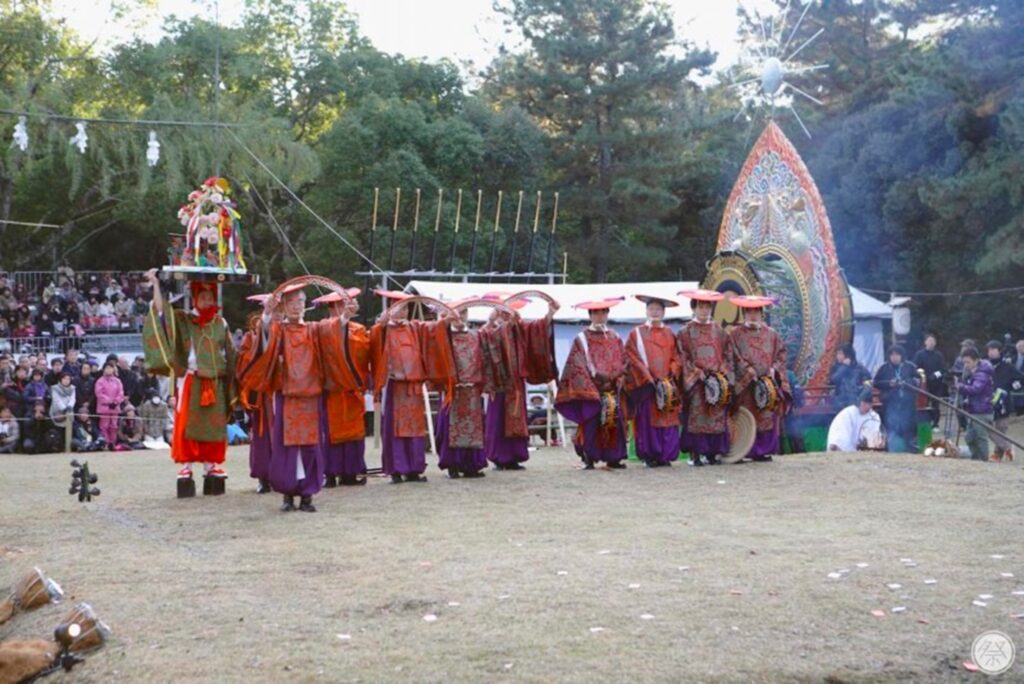
HARU Matsuri
Haru Matsuri literally means spring festival. The Japanese carry out a lot of activities and events, that traditionally were intended to pray for a new crop and to welcome the spring. With spring comes the blooming period, which for the Japanese means change, a new beginning.
During haru matsuri happens The Hanami.
Hanami comes from the words hana (flower) and miru (see)- “See flowers”. During Hanami, Japanese of all ages go to parts of the country where there are Sakura (cherry blossom). The main activity is the observation of the cherry trees.
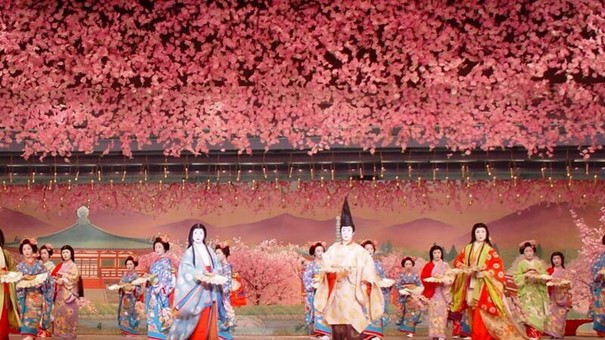
See video
Takayama Spring Festival credit : The Novel Nomad
O BON
O bon is a Buddhist matsuri ; during an important summer holiday families meet and family graves are visited.
(see our paragraph on Japan in page Buddhist Dances)
Shirasagi-no Mai
The “White Heron Dance,” is an ancient Japanese dance that almost died until its resurrection in November 1968 by the Asakusa Tourist Federation. They did this to celebrate Tokyo’s 100th year anniversary as the capital of Japan. The dancers make slow, graceful movements that reproduce the elegance of Heian manners (late 8th to 12th century Japan).
In Japan, the white heron is seen as a special bird because it can move between three elements: air, earth, and water. The bird can also be seen as a sign of good luck and a bringer of good harvest.
The procession is made up of six dancers dressed as white herons, one baton twirler, one bird feeder, and one parasol carrier.
The dance starts really slow with short and strong movements. The music describes the movements and the dancer’s timing is impeccable, it is not difficult to imagine them as birds. During the dance, the bird feeder moves around and throws confetti at the dancers.

Top Photo : Shinto Portal Credit : Voyage
